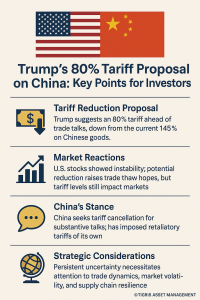Introduction
In a surprising turn of events, President Donald Trump has suggested implementing an 80% tariff on Chinese goods, a significant reduction from the current 145% rate. This proposal comes just ahead of high-stakes trade talks between the United States and China scheduled to take place in Switzerland. The announcement has sent ripples through global markets and raised questions about the future of international trade relations.
Historical Context
The US-China trade relationship has been marked by a series of escalations and negotiations over the past decade. Beginning with the trade war initiated during Trump’s first term, tariffs have been used as a primary tool to address trade imbalances and intellectual property concerns. The current tariff rate of 145% was established earlier this year as part of a broader strategy to pressure China into making concessions on various economic issues.
Details of the 80% Tariff Proposal
President Trump’s recent statement on Truth Social indicated that an 80% tariff on Chinese goods “seems right,” signaling a potential shift in the administration’s approach to trade negotiations. While the proposal represents a reduction from the existing rate, it remains substantially higher than pre-trade war levels. The White House has clarified that this figure is not a definitive policy but rather a starting point for discussions.
Economic Implications
Implementing an 80% tariff could have far-reaching consequences for both the US and global economies. For American consumers, higher tariffs typically translate to increased prices on imported goods, potentially exacerbating inflationary pressures. Businesses reliant on Chinese imports may face supply chain disruptions and increased costs, which could lead to reduced competitiveness and profitability. On a global scale, such a move could strain trade relationships and contribute to economic uncertainty.
Political Motivations
Analysts suggest that the tariff proposal may be driven by political considerations as much as economic strategy. By taking a hardline stance, President Trump may aim to project strength and determination in addressing trade imbalances, appealing to his political base. Additionally, the proposal could serve as a bargaining chip to extract concessions from China during the upcoming negotiations.
China’s Perspective and Response
China has historically responded to US tariffs with reciprocal measures, and the current situation is no exception. Chinese officials have expressed dissatisfaction with the existing tariffs and have called for their removal as a precondition for meaningful negotiations. The proposed 80% rate may still be viewed as excessively punitive, potentially hindering progress in the talks.
Global Market Reactions
The announcement has elicited mixed reactions from global markets. While some investors are hopeful that the proposal indicates a willingness to negotiate, others remain cautious about the potential for further escalation. Stock indices have experienced volatility in response to the news, reflecting the uncertainty surrounding the outcome of the trade talks.
Expert Opinions
Economists and trade experts are divided on the efficacy of the proposed tariff. Some argue that it could serve as a catalyst for productive negotiations, while others warn that it may provoke retaliatory measures and exacerbate economic tensions. The consensus is that a balanced approach, combining firm negotiation with strategic concessions, is essential for achieving a sustainable resolution.
Potential Outcomes of the Trade Talks
The upcoming negotiations in Switzerland present several possible outcomes. A successful agreement could lead to a reduction in tariffs and improved trade relations, benefiting both economies. Conversely, a failure to reach consensus may result in the continuation or escalation of the trade war, with detrimental effects on global economic stability.
Long-Term Strategic Considerations
Beyond the immediate economic impacts, the tariff proposal and ensuing negotiations have broader implications for international trade dynamics. The outcome could influence the formation of new trade alliances, shifts in global supply chains, and the balance of economic power. Strategic diplomacy and a focus on mutual interests will be crucial in navigating these complex challenges.
Conclusion
President Trump’s 80% tariff proposal marks a significant development in the ongoing US-China trade saga. As both nations prepare for critical negotiations, the world watches closely, recognizing that the decisions made in the coming days will have lasting effects on the global economic landscape. Achieving a balanced and strategic agreement is imperative for fostering stability and prosperity in international trade.



No Comments